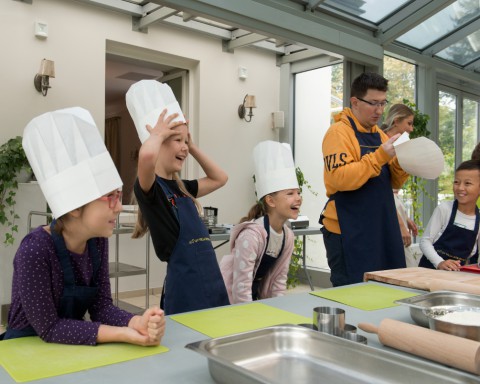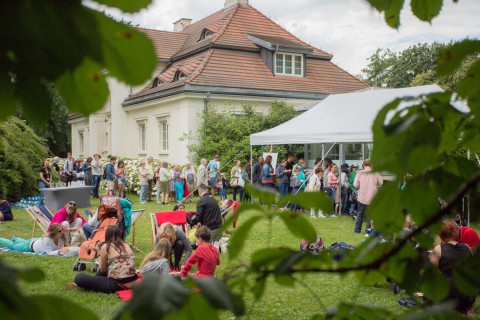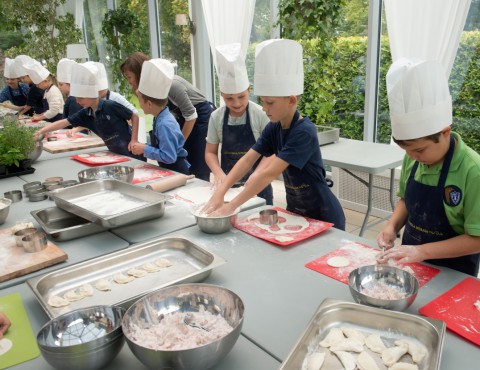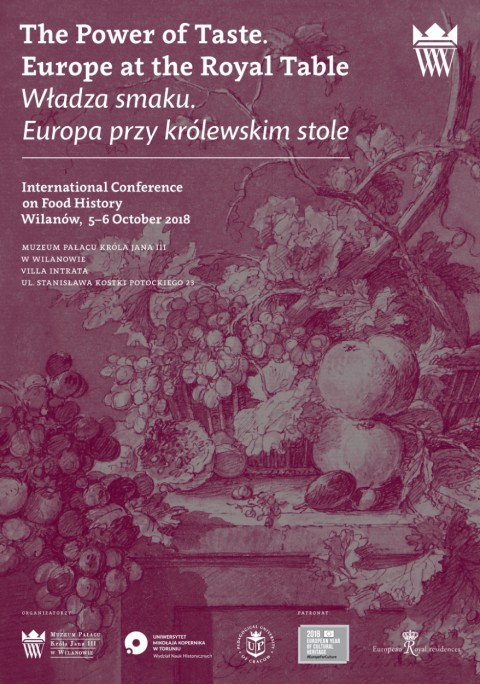“A Place at the Royal Table” among the winners of the European Heritage Awards / Europa Nostra Awards 2019

The Hague, 21 May 2019 – The winners of the European Heritage Awards / Europa Nostra Awards 2019, Europe’s most prestigious honour in the field, were announced today by the European Commission and Europa Nostra, the leading European heritage network. The 25 laureates from 16 countries have been recognised for their impressive accomplishments in conservation, research, dedicated service, and education, training and awareness-raising. The winners will be honoured at the high-profile European Heritage Awards Ceremony on 29 October in Paris, during the European Heritage Congress.
Europa Nostra Awards will also be given to two remarkable heritage achievements from European countries not taking part in the EU Creative Europe programme, namely Switzerland and Turkey.
Citizens from around Europe and the rest of the world can now vote online for the Public Choice Award and mobilise support for the winning achievement(s) from their own or another European country.
Among those dedicated individuals and exemplary European heritage initiatives that were awarded in 2019 are: the sensitive restoration of the Chapel of the Holy Shroud in Turin, an iconic site of religious heritage which was destroyed by fire in 1997 and which has now been reopened to the public; the development of a digital archive of the Roma, an internationally accessible space that would make Romani cultures and histories visible as well as respond to stereotypes with a counter-history told by Roma themselves; the dedication of one of the oldest heritage NGOs in Europe which has committed itself to heritage protection in Norway for over 175 years; and a training programme for displaced, skilled heritage specialists from Syria, run by a German institute in Istanbul, which serves as a powerful example for countries in Europe and beyond.
The European Commission and Europa Nostra have also announced a Special European Heritage Award to honour the Paris Fire Brigade. Together with the police forces and conservation experts, the city’s firefighters bravely and skilfully battled the flames which ravaged the Notre Dame cathedral on the night of 15 April and successfully protected the main structure of the monument from complete destruction, as well as the priceless artefacts within. Read the separate press release on this Special Prize in category “dedicated service to heritage” here.

“I am immensely proud to congratulate all winners of the European Heritage Awards / Europa Nostra Awards 2019. These heritage heroes - professionals and volunteers from across Europe – have accomplished something truly amazing. Their work to restore, preserve, support or promote Europe’s heritage monuments and sites, as well as the intangible heritage of Europe, is of the highest quality imaginable. The Awards are proof of the tremendous impact that heritage projects have on our economy, our environment, our culture and our quality of life. Europe's heritage is a key asset for Europe's future and our prosperity. This is an important message for all EU citizens and all future leaders of EU Institutions ahead of the forthcoming European elections”, stated Plácido Domingo, the renowned opera singer and President of Europa Nostra.
“Our cultural heritage is our joint resource, a legacy from the past on which to build our future. It has its place in people’s hearts and in their daily lives – and is crucial in fostering a sense of belonging. The European Year of Cultural Heritage that we celebrated in 2018 highlighted this important role. Now it is our task to keep promoting it in the years to come. This year’s winners of the European Heritage Awards/Europa Nostra Awards are playing their part in these efforts with their engagement and the quality of their work, and I warmly congratulate them,” said Tibor Navracsics, European Commissioner for Education, Culture, Youth and Sport.
Independent Juries of heritage experts from across Europe examined a total of 149 applications, submitted by organisations and individuals from 34 European countries, and selected the winners.
The laureates will be celebrated at the European Heritage Awards Ceremony, co-hosted by European Commissioner Tibor Navracsics and Maestro Plácido Domingo, and organised under the high patronage of the President of the French Republic, Emmanuel Macron, on the evening of 29 October in Paris.
Seven Grand Prix laureates (each of whom will receive €10,000) and the Public Choice Award winner, chosen from among this year’s winning projects, will be announced during the Ceremony.
The Ceremony will be attended by an audience of high-level officials from EU Institutions and Member States, leading representatives of heritage organisations and dedicated professionals and supporters from all over Europe.
The winners will present their heritage accomplishments at the Excellence Fair on 28 October. They will also contribute to various other events of the European Heritage Congress, to take place from 27-30 October 2019.
The Call for Entries for the 2020 edition of the Awards will be published in June 2019 on the dedicated website.
CONTACTS
Europa Nostra
Audrey Hogan
ah@europanostra.org, +31 70 302 40 52, +31 63 1 17 84 55
European Commission
Nathalie Vandystadt
nathalie.vandystadt@ec.europa.eu, +32 2 2967083
TO FIND OUT MORE
About each winning project:
Information and jury’s comments
Photos and Videos (in high resolution)
Press release in various languages
Creative Europe website
Commissioner Navracsics website

2019 AWARD WINNERS
(listed alphabetically by country)
Category Conservation
Castle of Montreuil Bonnin, FRANCE
Fortified Settlement of Mutso, GEORGIA
Chapel of the Holy Shroud, Turin, ITALY
Cathedral of Saint Bavo, Haarlem, THE NETHERLANDS
The Queen Louise Adit Complex, Zabrze, POLAND
Pavilion for the Presentation of Archaeological Remains, Celje, SLOVENIA
Lithica Quarry of s’Hostal, Menorca, SPAIN
Oratory of the Partal Palace in the Alhambra, Granada, SPAIN
The Portal of Glory, Santiago de Compostela, SPAIN
Medieval Tithe Barn, Ingatorp, SWEDEN
Yr Ysgwrn, Trawsfynydd, Wales, UNITED KINGDOM
Category Research
Solak 1: a Model of Predictive Archaeology, ARMENIA/ITALY
VERONA: Van Eyck Research in OpeN Access, BELGIUM
RomArchive – Digital Archive of the Roma, GERMANY
Category Dedicated Service
VVIA – Flemish Association for Industrial Archaeology, BELGIUM
Fortidsminneforeningen – National Trust of Norway, NORWAY
Category Education, Training and Awareness Raising
TUMO Center for Creative Technologies, Yerevan, ARMENIA
History Radar 1938, Vienna, AUSTRIA
Betina Museum of Wooden Shipbuilding, CROATIA
Monument Europe, Berlin, GERMANY
Stewards of Cultural Heritage, GERMANY
Greek Paths of Culture, Athens, GREECE
Commonlands: Cultural Community Mapping in Alpine Areas, Parco Nazionale Val Grande, ITALY
Le Dimore del Quartetto, Milan, ITALY
A Place at the Royal Table, Warsaw, POLAND
A Europa Nostra Award will also be presented to two remarkable heritage achievements from European countries not taking part in the EU Creative Europe programme.
Category Conservation
Boğaziçi University Gözlükule Excavation Research Center, Tarsus, TURKEY
Category Dedicated Service
Mr. Léonard Gianadda, Martigny, SWITZERLAND
A PLACE AT THE ROYAL TABLE, WARSAW, POLAND
A Place at the Royal Table, an initiative by the Museum of King Jan III’s Palace at Wilanów, aimed to share knowledge and experience about the culinary history of royal courts. Through the means of workshops, open-air activities and academic conferences they raised awareness about the culinary traditions and customs of European courts. The project was realised within the framework of the European Year of Cultural Heritage 2018, with similar activities taking place in royal palaces across Europe, as part of the Network of European Royal Residences.
“It is now widely acknowledged that food culture is an important intangible aspect of European heritage and mechanisms for the integration this knowledge into the wider understanding of heritage have recently come into sharper focus. Thanks to a greater emphasis on sensory exploration we can come closer to a greater understanding of the role of food in the past,” the jury said.
The results of the initiative are remarkable: over 200 workshops dedicated to culinary heritage took place in 2018. They ranged from cooking classes for all age groups to workshops on historical gardening and beekeeping. Up to 5000 people took part in the activities organised by the Museum of King Jan III’s Palace, not only strengthening relations with the local community, but also disseminating knowledge on the culinary heritage of Europe. In October 2018, the two-day international conference The Power of Taste. Europe at the Royal Table, brought together historians, scholars in food studies, museum curators, chefs and representatives of institutions promoting traditional food. Culinary journalists and food producers discussed the cultural relevance of food; both in the past and in today’s world. Culinary re-enactment sessions were arranged, supervised by chefs and specialists, in which the visitors could try their hand at 17th-18th century Polish recipes from 7 cookbooks which were published by the museum in previous years.
The jury appreciated the original and accessible approach of the project: “The presentation of the subject matter promotes a convincing historical and sensory environment and the project successfully avoids the trivial practices that often afflict similar projects. The museum lays great stress on engagement with various groups, including schoolchildren, families and adults. The project uses the potential of the existing museum, housed in the historic monument, to create added value through the development of participatory workshops based on empirical research and documentary evidence.”
More information: Ms. Elzbieta Grygiel, egrygiel[at]muzeum-wilanow.pl
BACKGROUND
European Heritage Awards / Europa Nostra Awards
The European Heritage Awards / Europa Nostra Awards were launched by the European Commission in 2002 and have been run by Europa Nostra ever since. They celebrate and promote best practices related to heritage conservation, research, management, voluntarism, education and communication. In this way, they contribute to a stronger public recognition of cultural heritage as a strategic resource for Europe’s economy and society. The Awards are funded by the Creative Europe programme of the European Union.
In the past 17 years, organisations and individuals from 39 countries have submitted a total of 3,032 applications for the Awards. Concerning the number of entries by country, Spain is first in the ranking, with 527 projects, followed by Italy, with 308 entries, and the United Kingdom, with 299 applications. With regard to the categories, Conservation has had the most submissions (1,744). Next comes Education, Training and Awareness-Raising (555), then Research (381), and, finally, Dedicated Service to Heritage (352).
Since 2002, independent expert juries have selected 512 award-winning projects from 34 countries. In line with the number of entries, Spain tops the list with 67 awards received. The United Kingdom is in second place (61 awards) and Italy comes third (45 awards). Regarding the categories, Conservation has the most winners (291) followed by Education, Training and Awareness-Raising (82), Dedicated Service to Heritage (76) and, lastly, Research (63).
A total of 116 Grand Prix of €10,000 have been presented to outstanding heritage initiatives, selected from among the award-winning projects.
The European Heritage Awards / Europa Nostra Awards highlight best practices, encourage the cross-border exchange of knowledge and connect various stakeholders in wider networks. The Awards bring major benefits to the winners, such as greater (inter)national exposure, follow-on funding and increased visitor numbers. In addition, the Awards foster a greater understanding of our shared heritage amongst the general public. The Awards are therefore a key tool to promote Europe’s heritage.
EUROPA NOSTRA
Europa Nostra is the pan-European federation of heritage NGOs which is also supported by a wide network of public bodies, private companies and individuals. Covering more than 40 countries in Europe, the organisation is the voice of civil society committed to safeguarding and promoting Europe’s cultural and natural heritage. Founded in 1963, it is today recognised as the most representative heritage network in Europe. Plácido Domingo, the world-renowned opera singer, is the President of the organisation.
Europa Nostra campaigns to save Europe's endangered monuments, sites and landscapes, in particular through the 7 Most Endangered programme. It celebrates excellence through the European Heritage Awards / Europa Nostra Awards. It also contributes to the formulation and implementation of European strategies and policies related to heritage, through a structured dialogue with European Institutions and the coordination of the European Heritage Alliance 3.3.
CREATIVE EUROPE
Creative Europe is the EU programme that supports the cultural and creative sectors, enabling them to increase their contribution to jobs and growth. With a budget of €1.46 billion for 2014-2020, it supports organisations in the fields of heritage, performing arts, fine arts, interdisciplinary arts, publishing, film, TV, music, and video games as well as tens of thousands of artists, cultural and audiovisual professionals. The funding allows them to operate across Europe, to reach new audiences and to develop the skills required in the digital age.
suggested

Historic culinary re-enactment programme "A Place at the Royal Table"
A Place at the Royal Table - programme realised in frames of European Year of Cultural Heritage 2018 within the …

A Place at the Royal Table | report from workshop
15 March 2018 brought Sokółka cooking school students to the royal table at the Museum of King Jan III’s Palace at Wilanów. That is how the Museum of King Jan III’s Palace at Wilanów welcomed the European Year of Cultural Heritage 2018 and launched “A Place at the Royal Table” project co-created by 19 royal residencies in 11 European countries.

Conference „The Power of Taste. Europe at the Royal Table” October 5-6, 2018
The international conference „The Power of Taste. Europe at the Royal Table” in the Museum of King Jan III’s Palace …

Old Polish cookbooks - "Compendium ferculorum or Collection of Dishes" (1682)
Stanislaw Czerniecki's book is characterised by elaborate composition, sophisticated concepts and surprising ideas of the author, who pays homage to …




















